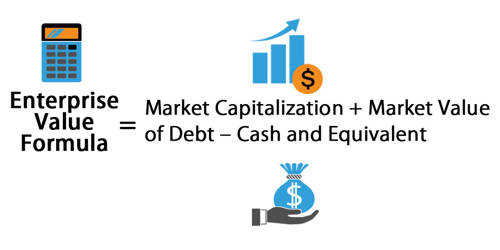Enterprise value (EV) or firm value (FV) is an economic measure reflecting the market value of a business (i.e. as distinct from market price). It is a measure of a company’s total value, often used as a more comprehensive alternative to equity market capitalization. It is a sum of claims by all claimants: creditors (secured and unsecured) and shareholders (preferred and common). Enterprise value is one of the fundamental metrics used in business valuation, financial modeling, accounting, portfolio analysis, and risk analysis. It is a popular metric used to value a company for a potential takeover. It represents the economic value of a company.
Enterprise value is more comprehensive than market capitalization, which only reflects common equity. It is used as the basis for many financial ratios that measure the performance of a company. Importantly, EV reflects the opportunistic nature of business and may change substantially over time because of both external and internal conditions. It helps in comparing companies of different capital structures. Therefore, financial analysts often use a comfortable range of EVs in their calculations.
The simple formula for enterprise value is: EV = Market Capitalization + Market Value of Debt – Cash and Equivalents.
Formula and Calculation for EV
EV = MC + Total Debt − C
where: MC = Market capitalization; equal to the current stock price multiplied by the number of outstanding stock shares
Total debt = Equal to the sum of short-term and long – term debt
C = Cash and cash equivalents; the liquid assets of a company, but may not include marketable securities.
Usage
Enterprise value is used as the basis for many financial ratios that measure the performance of a company. Because EV is a capital structure-neutral metric, it is useful when comparing companies with diverse capital structures. EV is a measure of a company’s total value, often used as a more comprehensive alternative to equity market capitalization. Price/earnings ratios, for example, will be significantly more volatile in companies that are highly leveraged.
Stock market investors use EV/EBITDA to compare returns between equivalent companies on a risk-adjusted basis. It tells us about the worth of the company. In other words, it’s a theoretical take over price. They can then superimpose their own choice of debt levels. In practice, equity investors may have difficulty accurately assessing EV if they do not have access to the market quotations of the company debt. It is not sufficient to substitute the book value of the debt because a) the market interest rates may have changed, and b) the market’s perception of the risk of the loan may have changed since the debt was issued. While market cap is simply a company’s stock price multiplied by the total number of shares outstanding, Remember, the point of EV is to neutralize the different risks, and costs of different capital structures.
Buyers of controlling interests in a business use EV to compare returns between businesses, as above. They also use the EV valuation (or a debt-free cash-free valuation) to determine how much to pay for the whole entity (not just the equity) since the change of control may require debt repayment. Returns from different businesses can be compared to the ones interested in buying controlling stakes. They may also want to change the capital structure once in control.
















